EMAIL MARKETING
Turn Your Emails to Gold: How to Increase Your Email CTR

There’s gold at the end of the rainbow when it comes to your email marketing — you just need to make sure you’re on the right track towards finding it.
Email has one of the most impressive ROIs of all marketing endeavors at $38 earned for every $1 spent. That alone should be a huge incentive to get it right. However, there are many less tangible benefits that are equally worth your pursuit — including increased brand awareness and recognition, higher conversion rates, and a more satisfied, more engaged audience.
Of course, these benefits don’t happen overnight, nor are they a guarantee. To make email marketing work for you and reach that elusive pot of gold, you need to strategize. Set your sights on specific tactics and outcomes that can take your emails to the next level and help you get more bang for your buck when combined with other best practices.
In this guide, we’re focusing on one of the metrics that play a huge role in the overall success of your email marketing: your click-through rate. We’ll be covering why it’s so important, along with simple things you can do to create your own luck and get more clicks that matter.
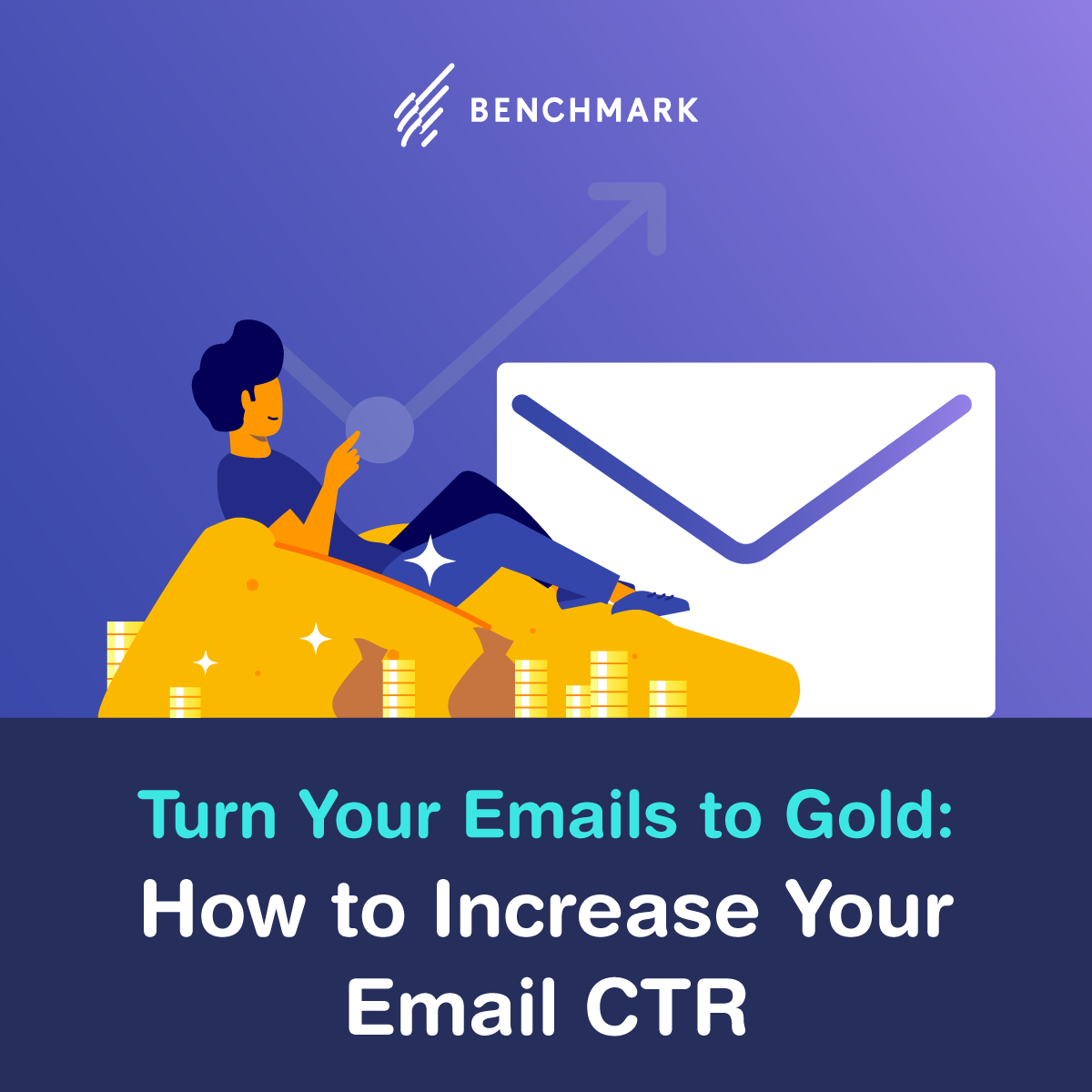
What is an Email Click-Through Rate?
Your click-through rate (CTR) refers to the ratio of people who click on a link in your email versus the number of people who saw it.
For example, let’s say you send out 10,000 emails and get 2,000 leads to a click on one of your email’s links. Your click-through rate would be 20 percent, using the CTR formula of the number of clicks divided by the number of opens multiplied by 100.
Notable here is that the dividing factor is the number of impressions, not the number of opens, with every delivered email counting as an impression. If you send out 10,000 emails and only 9,500 make it to an inbox (meaning they don’t bounce or get sent to spam), then you would divide by 9,500, not 10,000.
How Does CTR Compare to Other Email Metrics?
Click-through rate should be studied in conjunction with other email metrics to get a complete picture of the efficiency of your campaign. Click-through rate and open rate are considered to be the top email metrics, but neither should be fully relied on for email success.
Open rate looks at the number of recipients who open your emails. This metric is useful but not as compelling if those same recipients don’t convert or click on your links. Also, with Apple’s iOS15 update, open rate is ultimately inaccurate, depending on how many of your subscribers are Apple users and have opted into the new privacy features.
Click-to-open rate combines the insight from open rate and CTR to provide a more concrete measurement of success. It combines open rate and click-through rate by taking the percentage of recipients who open your emails and click your links.
Why Your Email CTR Matters
Your click-through rate clues you in on a few key insights that you can’t gain from looking at your deliverability and open rates alone. These include:
- How engaged your audience is
- How interested your audience is in the content you’re sharing
- How audience interest changes over time
If you’re looking at your CTRs and aren’t impressed by the numbers, you’re not alone. The average click-through rate is quite low, with an industry-wide CTR of just 2.6%. The industry with the highest click-through rates — government and politics — clocked in at just 6 percent. Retail came in at the lowest, with a CTR of 1.10 percent. Yikes.
What makes this metric so elusive is exactly what makes it so essential to your overall email marketing success. Getting into an inbox and getting an open are big steps, but it’s your click-through rates that really bridge the gap between subscriber and lead or customer. CTRs tell you who’s interested in what you’re selling, and even more notably, who’s most likely to buy.
What’s a Good CTR?
Click-through rates vary by industry, and if you search the web, you’ll find a ton of different answers regarding what the average email CTR rate is and what a good CTR rate is. From our experience and research, we’d say that an average click-through rate is around 2.5 – 2.6%, making anything above that pretty darn good.
The Various CTRs
Yes, there are “categories” of CTRs to keep in mind. Knowing more about what they are will help you determine what you’re measuring.
- TCTR or total click-through rate – Measures the total number of clicks the links in your email receives. If your TCTR is high, that means the recipients of your email opened and clicked on the link in your email multiple times. We don’t recommend relying on this for success, as you can’t differentiate between which clicks are from the same person on multiple devices (or if links are just being clicked on repeatedly).
- UCTR or unique click-through rate – Measures how many unique clicks each link gets in an email. If a recipient opens the same email on two different devices, it will only be counted once, which helps avoid the confusion that comes with TCTR. In a nutshell, unique click-through rate tracks how many links are clicked by each unique subscriber.
5 Ways to Increase Your Email Click-Through Rate
Now let’s get to the good stuff: the specific things that you can do to boost your click-through rate and, by default, your email performance.
You might be doing some of these already since there’s a significant overlap between the tactics that improve your CTR and the tactics at the foundation of basic email hygiene. But the more, the merrier, so look through to see if there are any gaps in your email marketing strategy that could inadvertently be harming your CTR.
1. Make Your Emails Mobile Friendly
There’s a strong connection between the device that your subscribers are using and how often they click through, especially when you consider that 70% of your subscribers will automatically delete an email that isn’t optimized for their device.
In the U.S., mobile internet traffic is gaining speed on desktop, accounting for 40.61% of all traffic in the first quarter of 2019. If your emails look great on a computer but don’t translate into a mobile format, you’re taking a huge risk — and likely losing out on a ton of potential clicks in the process.
A responsive email design on mobile can increase your click-through rate by 15%, from a 2.7% average CTR to a 3.3%. Not too shabby for such a simple fix.
2. Rethink Your Layout
A simple email redesign can have a serious impact, and that includes increasing your CTR.
Making conscious email design choices that point your audience in the direction of your most valuable links isn’t sneaky — it’s smart thinking. Put the focus on your content and your CTA, and take it off heavy blocks of text and non-essential images.
If you aren’t sure about a certain layout, test two different kinds to see which yields higher results.
3. Test, Test, and Test Again
A/B testing is your friend when it comes to email conversion rates, particularly your CTR. So why are so few brands doing it?
More than 65% of brands rarely or never A/B test their automated emails. But set-it-and-forget-it complacency isn’t where great emails come from. You want to regularly test out features that impact your key conversions to see what tracks best with your audience and what’s failing to grab their attention.
Go into your A/B testing endeavor with a clear idea of what you’re trying to find out. In terms of your click-through rates, that’s going to be things like link placement and size, the time and day you send your emails, and how you position your copy around the link to encourage clicks.
Will a blue button garner more clicks than a yellow one? Will including an image with your CTA increase your rates? Will you get a higher CTR if you send on Thursdays instead of Wednesdays? A/B testing can answer these questions — and take the guesswork out of what features need to be a mainstay of your campaigns.
4. Include Just One CTA
More than 90% of subscribers who read your headline copy also read your CTA copy. And while it’s tempting to want to cast a wide net with your CTAs, it pays to keep eyes on the prize.
Content clicks are crucial, but your CTA is where the gold is. By narrowing it down to just one — and making it stand out as much as possible — you help ensure that the click-throughs you do get are of the highest value. It plays off of one of the biggest marketing design truisms, which is that when it comes to choice, less actually is more.
Once again, A/B testing is important. In addition to playing around with colors, fonts, and formats, thoroughly test your CTA placement so that you really make it count.
5. Target Your Content
Segmenting your audience so that you send the right content to the right people can boost your conversion rates by more than 203%.
Your audience is busy, and they’re usually rushing through their emails. To snag their attention, everything from your subject line to your body copy needs to be optimized to their preferences, interests, and where they are in the sales funnel. The more personal you can get, the more likely you are to capture their interest — and turn that interest into a click.
If it sounds like a lot of back-end work to ensure you send out targeted content, you’re in luck. Email marketing automation can do a ton of the heavy lifting of personalization and contact list segmentation for you. All you have to do is make sure you’ve accurately defined your audience groups in the first place. In fact, email marketing automation can help you with A/B testing and quicker reformatting — all of which are integral to acing your CTR game.
Any click-through rate boost you can get is worth striving for. Follow the advice above to start gaining more clicks, more leads, and more happy customers.
First seen at Benchmarkemail.com
EMAIL MARKETING
Unveiling the Future of Email Marketing: 4 Trends to Revolutionize Engagement

In today’s fast-paced digital landscape, the efficacy of email marketing hinges not only on the delivery of messages but also on their ability to resonate with audiences and drive meaningful interactions. Gone are the days of generic blasts; instead, companies are increasingly turning to innovative strategies to captivate their subscribers. Here, we delve into four emerging trends poised to redefine the realm of email marketing, promising to elevate engagement and drive conversions.
1. User-Generated Content (UGC) Takes Center Stage
User-generated content (UGC) emerges as a potent tool in the arsenal of email marketers, facilitating authentic connections with audiences while amplifying brand visibility. From customer reviews to social media posts, UGC offers a dynamic and relatable portrayal of products and services, resonating with consumers in the era of “new sincerity.”
By harnessing UGC within newsletters, brands gain invaluable insights into consumer preferences and behaviors, fostering trust and credibility. Strategies such as incentivized contests or social media challenges empower users to contribute content willingly, fueling a steady stream of authentic engagement.
2. Augmented and Virtual Realities (AR/VR) Transform Experiences
Augmented reality (AR) and virtual reality (VR) technologies emerge as game-changers in the realm of email marketing, offering immersive experiences that captivate and compel audiences. While VR may require substantial investments and specialized equipment, AR presents a more accessible avenue for brands to showcase products and drive engagement.
From interactive product demonstrations to virtual try-on experiences, AR/VR initiatives promise to revolutionize email campaigns, offering users a glimpse into a digitally enhanced world. While technical constraints may limit current implementations, ongoing advancements herald a future where AR/VR seamlessly integrate into email communication, enriching brand experiences.
3. Omnichannel Integration Enhances Connectivity
The advent of omnichannel marketing heralds a new era of seamless connectivity, enabling brands to orchestrate cohesive experiences across diverse touchpoints. By unifying customer interactions across websites, offline stores, and email communications, businesses cultivate deeper insights and deliver personalized content tailored to individual preferences.
Omnichannel integration not only streamlines the customer journey but also fosters brand loyalty by offering consistent and personalized experiences. Whether browsing online, engaging in-store, or interacting via email, customers encounter a unified brand identity, enhancing engagement and driving conversions.
4. Hyper-Segmentation and Personalization Drive Relevance
In an age defined by personalized experiences, hyper-segmentation emerges as a cornerstone of effective email marketing strategies. By dissecting audiences into granular segments based on demographics, behaviors, and preferences, brands can deliver tailored content that resonates on a profound level.
Utilizing advanced email marketing platforms, businesses can leverage hyper-segmentation to craft personalized campaigns that speak directly to individual interests and needs. From dynamic product recommendations to targeted promotions, personalized emails foster a sense of relevance and exclusivity, driving engagement and fostering long-term customer relationships.
In conclusion, the future of email marketing lies in innovation and adaptation, with brands leveraging cutting-edge technologies and strategic approaches to engage audiences effectively. By embracing trends such as user-generated content, augmented reality, omnichannel integration, and hyper-segmentation, businesses can unlock new realms of engagement, driving meaningful interactions and fostering brand loyalty in an ever-evolving digital landscape.
EMAIL MARKETING
Top Email Marketing Strategies To Use For Q4
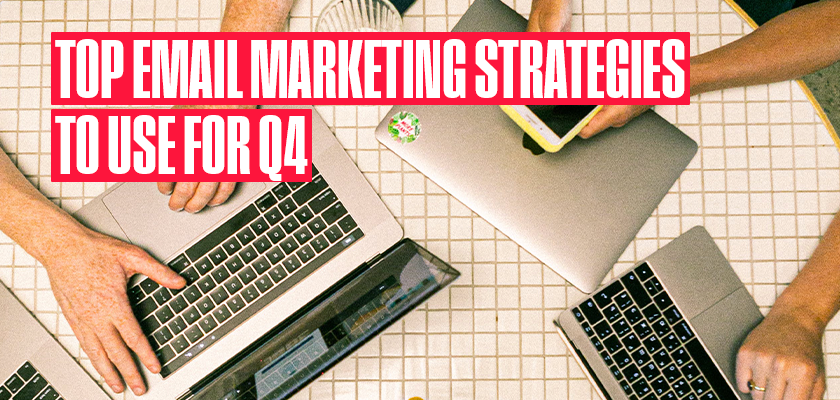
As we approach the Q4 period, it’s never too early to start preparing for your Black Friday and Cyber Monday email marketing strategy. Once Black Friday week hits, our inboxes are filled with a hurricane of brands fighting for attention, each with the ‘biggest’ and the ‘best’ offers you won’t get anywhere else.
To set your brand apart from the competition, it’s crucial to plan ahead. Over 60% of brands send out multiple emails over the course of the Black Friday/ Cyber Monday weekend, and it’s a perfect time to up your brand awareness ahead of the Christmas shopping season.
If you’re not sure where to start with Q4 planning or need some last-minute tips to enhance your strategy, we’ve outlined some top email marketing strategies to incorporate into your plans!
1. Send Pre-Black Friday Emails
Sending pre-Black Friday emails is great for keeping your brand at the forefront of people’s minds ahead of the big day. Not only will a pre-Black Friday email let your audience know about your upcoming event, but it will also ensure that your audience is regularly checking in on your brand throughout the Q4 period.
Additionally, sending pre-Black Friday emails is beneficial for A/B testing. Sending out different formats of emails with minor tweaks, such as the CTAs or subject lines, can help you determine what your audience is more likely to engage with so you can then tailor your Black Friday strategy accordingly.
2. Run a Lead Gen
It might seem like a given, but ahead of Black Friday, it’s beneficial to give your email list a much-needed boost. A simple but effective way to do this is to run a lead-generation advertising campaign. For example, offering your audience the chance to win a prize in return for submitting details, such as their email address, is a quick and easy way to increase your list size. Similarly, refreshing your pop-up on-site with an irresistible offer will also contribute to gaining new profiles.
3. Offer Something Unexpected
Email marketers only have 3 seconds to capture the attention of their readers, which isn’t surprising due to the amount of emails the average person will receive daily. If an email isn’t driving you to click on it, it swiftly gets forgotten about and lost within their inbox. Over Black Friday, to avoid this happening, make sure you’re offering something unexpected, whether that’s a mystery discount or a gift with each purchase!
One of the worst things you can do over Black Friday is to overcomplicate your promotions. If you’re offering multiple promotions and codes, things can get a bit too hectic. To make it as simple as possible, consider running a standard “up to” percentage amount. If you want to include a code, it helps to have this auto-applied at checkout to avoid customers dropping off if they input it incorrectly. In the design of your email, make sure the promotion is clearly highlighted within the design so it can’t be missed, and also referenced in the body copy and subject lines too!
5. Create An Effective Design
Creating an effective design is one thing, but how do you know what works? To improve your email campaigns, consider running an A/B test to pinpoint which elements of your design are improving the CTR and which are hindering it.
Highlighting metrics such as colour, font size, and CTAs can instantly impact whether people will click through or discard! If a consumer clicks on your email, you’ll have, on average, 11 seconds to keep their attention, so making sure your design stands out for the wave of other Black Friday content is key! Keep the design of your email reflective of your branding but with stand-out elements specifically for the shopping season.
6. Make Use Of CTAs
CTAs (call-to-action) are one of the most underrated parts of any email campaign, especially over the Black Friday period. They’re one of the driving forces behind making your email recipients turn into passive readers to customers. One key way to make your CTAs stand out is to make use of bright and bold colours that will attract and hold attention. Additionally, it’s important to think about the placement of your CTAs to increase your click-through rate, make sure the copy used is clear and concise (between two and five words) and use actionable language.
7. Focus On Subject Lines
Subject lines are make or break for every email campaign. Over Black Friday, consumers’ inboxes are cluttered with emails, so it’s important to stand out. It’s estimated that on Black Friday, 116.5 million emails from brands were sent out (more than any other day), and Black Friday sees the highest number of emails opened and clicked. To prevent your emails from being lost in the void, having a cracking subject line to stand out from competitors is everything.
The secret to a great subject line is to keep it short and snappy. On average, subject lines with 50 characters or less tend to get an average of 12% higher open rates and 75% higher click-through rates. Including emojis within subject lines has been seen to increase click-through-rates by as much as 28%!
Additionally, it helps to use language that will really pique your audience’s interest, stay away from any overused cliches and keep them as attention-grabbing as possible.
8. Prep for Cyber Monday
To plan an effective Black Friday, it’s crucial to prepare for Cyber events too. With Cyber following straight after, it’s easy to forget about it or not prioritise it as much as Black Friday, however, it’s still an extremely profitable day! To make the most of it, create dedicated campaigns and tailor your online sales messaging so that it focuses on driving urgency.
9. Incorporate SMS into Your Strategy
Sometimes the importance of SMS can be overlooked because a lot of brands assume that text messages won’t fit in with their brand. However, it’s a no-brainer for reaching even more customers. On average, 82% of people engage with marketing content on their smartphones, so it’s something to definitely explore, especially over the busy shopping period.
To gain SMS sign-ups, you can effectively tie your SMS campaign in with your lead generation and ask for customers to fill out their phone number as well as their email address. That way, they’ll be opted into your send list. It can also be used to send reminders when sales have launched or when offers are coming to a close.
Despite having only 160 characters to work with, SMS campaigns are longer than recommended email subject lines, so it can be just as, if not more effective than email marketing campaigns.
EMAIL MARKETING
Mastering Email A/B Testing for Mobile Apps: The Ultimate Guide
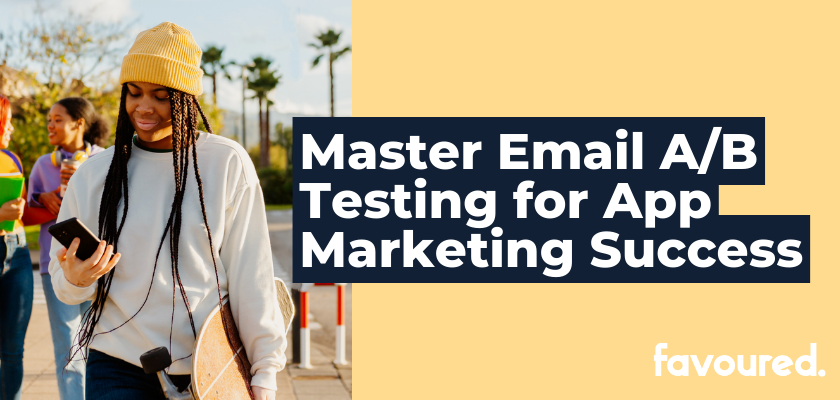
Welcome to the world of email A/B testing for mobile apps!
Here at Favoured, we’re all about delivering the best results for our clients, and that includes mastering the art of email marketing. In this guide, we’ll take you through the essentials of A/B testing your email campaigns to achieve maximum success for your mobile app.
What Is Email A/B Testing?
Email A/B testing, also known as split testing, is a method used to compare two or more variations of an email campaign to determine which one performs better. The goal is to identify the version that resonates most with your target audience, ultimately leading to higher open rates, click-through rates, and overall engagement.
In the context of mobile apps, email A/B testing can be particularly valuable, as it helps you fine-tune your marketing messages to drive user acquisition, engagement, and retention.
Benefits Of Email A/B Testing
There are numerous advantages to incorporating A/B testing into your email marketing strategy for mobile apps. Some of the key benefits include:
- Improved open rates: By testing different subject lines, you can identify which ones capture your audience’s attention and entice them to open your emails.
- Increased click-through rates: Experimenting with various email elements, such as CTAs and layout, can help you determine the most effective ways to encourage recipients to take action.
- Enhanced engagement: A/B testing allows you to create more relevant and engaging content for your target audience, resulting in higher conversion rates and stronger user relationships.
- Data-driven decision making: With A/B testing, you can make informed decisions based on actual user behaviour, rather than relying on assumptions or gut feelings.
Key Metrics To Track
When conducting email A/B tests, it’s essential to track specific metrics to gauge the success of your campaigns. Some of the most critical metrics to monitor include:
- Open rate: The percentage of recipients who open your email. This metric can help you evaluate the effectiveness of your subject lines.
- Click-through rate (CTR): The percentage of recipients who click on a link within your email. A high CTR can indicate that your email content is engaging and relevant.
- Conversion rate: The percentage of recipients who take the desired action after clicking a link in your email, such as downloading your app, making a purchase, or signing up for a newsletter.
- Unsubscribe rate: The percentage of recipients who opt out of receiving future emails from you. A high unsubscribe rate may suggest that your email content is not resonating with your audience.
Understanding the basics of email A/B testing is the first step towards optimising your mobile app marketing campaigns. By grasping the concept, benefits, and key metrics of A/B testing, you’ll be well-equipped to make data-driven decisions that drive real results for your mobile app.
Setting Up Your Test
Defining Your Goal
Before you start setting up your A/B test, it’s crucial to determine the primary objective of your test. Having a clear goal will help you focus your efforts and make data-driven decisions based on the results. Your goal should align with your overall mobile app marketing strategy and be specific, measurable, attainable, relevant, and time-bound (SMART). Examples of goals for email A/B tests include:
- Increasing the open rate by 10% within 30 days
- Boosting the click-through rate by 15% within 60 days
- Reducing the unsubscribe rate by 5% within 45 days
Selecting Variables To Test
Once you’ve set your goal, it’s time to choose the variables to test in your email campaign. The variables you select should have a direct impact on your goal and be something you can measure. Here are some common email elements to consider testing:
- Subject lines: Test different wording, phrasing, or personalisation techniques to capture your audience’s attention.
- Email content: Experiment with different content styles, lengths, or structures to see what resonates with your recipients.
- Call-to-action (CTA): Try various CTA placements, wording, or button designs to encourage users to take the desired action.
- Images and visuals: Test different images, colours, or visual layouts to determine which one drives higher engagement.
- Personalisation: Compare personalised content, such as using the recipient’s name, to generic content to assess its impact on your metrics.
Creating Variations
Now that you’ve chosen your variables, it’s time to create the variations for your email campaigns. Keep the following tips in mind when crafting your variations:
- Limit the number of variations: While it may be tempting to test multiple variations, it’s best to limit yourself to two or three, so you don’t dilute your results or prolong the testing process.
- Make distinct changes: Ensure the variations are different enough to provide meaningful insights. For instance, if testing subject lines, one could be a question, while the other could be a statement.
- Keep other elements consistent: To ensure accurate results, only change the variable you’re testing and keep all other elements the same across variations.
- Consider your audience: When creating variations, take into account your target audience’s preferences and behaviours to craft relevant and engaging content.
Setting up an A/B test for your mobile app’s email campaigns is an essential step towards optimising your marketing efforts. By defining your goal, selecting the right variables to test, and creating effective variations, you’ll be well on your way to enhancing your app’s performance and building stronger relationships with your users.
Implementing & Analysing Your Test
Test Duration & Sample Size
Determining the optimal test duration and sample size is crucial for obtaining accurate and reliable results. Here are some factors to consider when deciding on these parameters:
- Test duration: The length of your test should be long enough to gather sufficient data, but not so long that it delays your marketing efforts. Generally, a test duration of 7 to 14 days is recommended for most email A/B tests.
- Sample size: Your sample size should be large enough to provide statistically significant results. Use an A/B test sample size calculator to determine the appropriate size based on your desired confidence level and the expected difference between variations.
Keep in mind that these recommendations may vary depending on your specific circumstances, such as the size of your email list or the frequency of your email campaigns.
Launching Your Test
Once you’ve determined the test duration and sample size, it’s time to launch your A/B test. Follow these steps to ensure a smooth test launch:
- Segment your email list: Divide your email list into random, equal-sized groups to ensure a fair comparison between variations.
- Send your variations: Schedule your email campaign to send the different variations to the corresponding segments of your email list.
- Monitor the progress: Keep an eye on the key metrics, such as open rates, click-through rates, and conversion rates, throughout the test duration to ensure everything is running smoothly.
Analysing Results & Drawing Conclusions
After your test has concluded, it’s essential to analyse the data, draw conclusions, and apply your findings to future email campaigns. Here’s how to go about it:
- Review the data: Examine the key metrics for each variation and compare them to determine which one performed better.
- Check for statistical significance: Use an A/B test calculator to ensure the differences between the variations are statistically significant, indicating that the results are not due to random chance.
- Draw conclusions: Based on the data, determine what you’ve learned from the test and how it can inform your future email marketing efforts. For instance, if a specific subject line format led to higher open rates, consider using a similar approach in future campaigns.
- Apply your findings: Incorporate your learnings into your email marketing strategy to continually optimise your campaigns and drive better results for your mobile app.
Implementing and analysing your email A/B tests is a critical step towards optimising your mobile app marketing campaigns. By determining the appropriate test duration and sample size, launching your test, and analysing the results, you’ll be able to make data-driven decisions that enhance your app’s performance and foster stronger relationships with your users.
Best Practices
Consistent Testing
To achieve long-term success in email marketing for mobile apps, it’s crucial to make A/B testing a consistent part of your strategy. Regular testing allows you to:
- Continuously optimise your campaigns: Stay ahead of the curve by continually refining your email campaigns based on data-driven insights.
- Adapt to changing trends: Keep your email marketing efforts relevant and up-to-date by adapting to evolving user preferences, industry trends, and market dynamics.
- Validate new ideas: Use A/B testing to validate new marketing concepts or tactics before fully implementing them in your campaigns.
Avoiding Common Pitfalls
As with any marketing endeavour, there are potential pitfalls to watch out for when conducting email A/B tests. Here are some common mistakes and how to avoid them:
- Testing too many variables at once: Focus on testing one variable at a time to ensure accurate results and avoid confusion when analysing the data.
- Ignoring statistical significance: Make sure your test results are statistically significant to avoid drawing conclusions based on random chance or insufficient data.
- Focusing solely on short-term gains: While it’s essential to optimise for immediate results, also consider the long-term impact of your email marketing strategy on user retention and lifetime value.
Utilising Automation & Growth Hacking Strategies
Leveraging automation and growth hacking techniques can help streamline your email A/B testing efforts and drive even better results for your mobile app. Consider the following strategies:
- Email automation: Use email marketing automation tools to schedule and send your A/B tests, track key metrics, and segment your email list efficiently.
- Dynamic content: Implement dynamic content in your email campaigns to personalise messages based on user behaviour, preferences, or demographics, and A/B test the effectiveness of various personalisation techniques.
- Multivariate testing: Once you’re comfortable with A/B testing, consider using multivariate testing to assess the impact of multiple variables simultaneously and identify the best combination of elements for your campaigns.
Mastering email A/B testing for your mobile app is an ongoing process that requires consistent effort, learning, and adaptation. By following best practices, avoiding common pitfalls, and utilising automation and growth hacking strategies, you’ll be well on your way to achieving long-term success in your email marketing campaigns.
As a data-driven full-funnel marketing agency, Favoured believes in the power of optimising every aspect of the customer journey, and that includes email marketing.
We’re dedicated to helping businesses drive real results, and A/B testing plays a crucial role in this process. Reach out if you want to supercharge your email campaigns with us. Happy testing!
-

 SEARCHENGINES7 days ago
SEARCHENGINES7 days agoGoogle Core Update Volatility, Helpful Content Update Gone, Dangerous Google Search Results & Google Ads Confusion
-
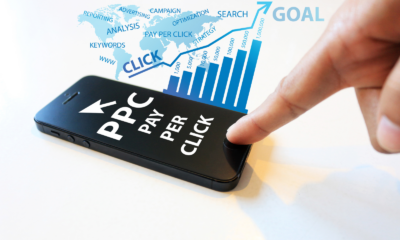
 SEO7 days ago
SEO7 days ago10 Paid Search & PPC Planning Best Practices
-
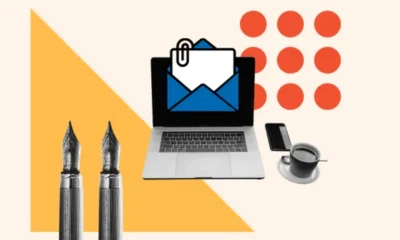
 MARKETING5 days ago
MARKETING5 days ago5 Psychological Tactics to Write Better Emails
-

 SEARCHENGINES6 days ago
SEARCHENGINES6 days agoWeekend Google Core Ranking Volatility
-

 MARKETING6 days ago
MARKETING6 days agoThe power of program management in martech
-

 SEO6 days ago
SEO6 days agoWordPress Releases A Performance Plugin For “Near-Instant Load Times”
-

 PPC5 days ago
PPC5 days ago20 Neuromarketing Techniques & Triggers for Better-Converting Copy
-
SEARCHENGINES5 days ago
Daily Search Forum Recap: April 15, 2024








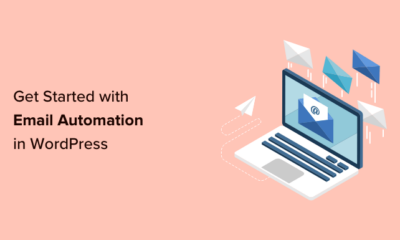



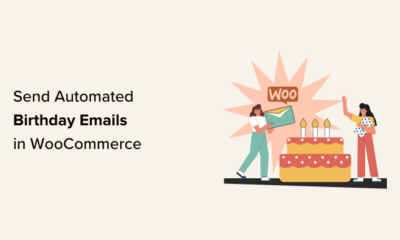



You must be logged in to post a comment Login